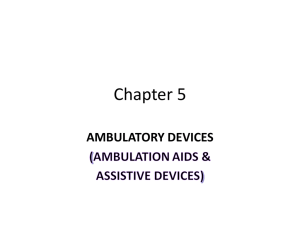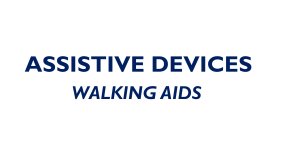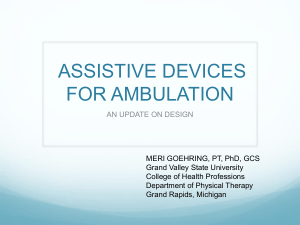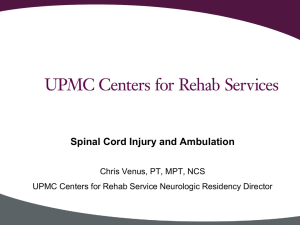AMBULATION AND GAIT TRAINING
advertisement
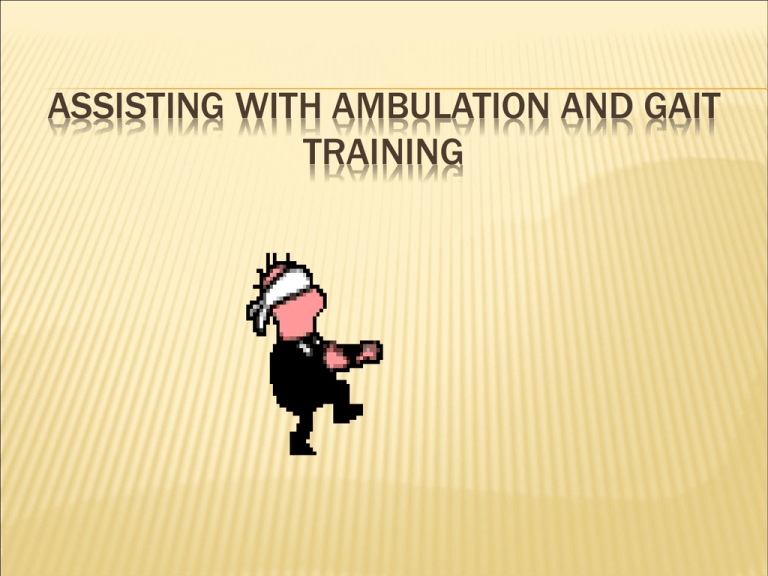
ASSISTING WITH AMBULATION AND GAIT TRAINING KEY TERMS TO KNOW… Ambulation- act of walking or being able to walk Ambulation aid- piece of equipment used to provide support or stability to a person while walking Gait- the manner or style of walking Unilateral- one sided Bilateral- two sided or both sides Extremities- arms (upper) or legs (lower) ASSISTING WITH AMBULATION AND GAIT TRAINING Assistive devices are used to make safe ambulation possible 3 MAIN INDICATIONS 1) decreased ability to bear weight on the lower extremities (legs) 2) muscle weakness or paralysis of the trunk or lower extremities 3) poor balance in the upright posture THINK 15 year old boy fractures RLE – tibia and fibula. The boy had surgery to repair and doctors orders NWB for 2 months. As the physical therapist, what assistive device will you instruct him to use? WE NEVER KNOW WHEN WILL WE NEED - ? WHAT ASSISTIVE DEVICE WILL YOU CHOOSE? STATE STANDARDS 6.3 Demonstrate appropriate use of equipment and devices as directed by rehab professionals. PREVIOUS LEARNING What device have we already learned about? Crutches Artificial supports that assist a patient who needs help walking. Ordered by a physician Made of wood or aluminum CRUTCHES How do you fit patient for crutches? #1 Measurement points: Height of heels on shoes: low broad heels, approx. 1 to 1 ½ inches high, non skid soles Position crutches: 4-6 inches to the side and front of the pt’s foot Distance b/t axilla and axillary bar: 2 inches Degree angle for elbows: 25 – 30 degrees TYPES OF CRUTCH WALKING #2 Bear weight on both legs – 4-point gait Each step is separate: (crutch- opposite footcrutch-opposite foot) Used: cannot bear full weight on either leg CRUTCH WALKING, CONTINUED #2 continued When 4-point is mastered then the pt can advance to: 2-point 1) Crutch-opposite foot (move together) 2) Crutch-opposite foot (move together) CRUTCH WALKING, CONTINUED After the patient gains strength in the arms and shoulders, faster gaits such as the swing-to or swingthrough are taught Swing-to: Move both crutches forward Move feet up to crutches Swing-through: Move both crutches forward Swing both legs in front of crutches CRUTCH WALKING #3 – If a pt can bear weight on only 1 leg, the first crutch gait taught is the 3-point Move both crutches and the weak foot at the same time (3) Then advance the good foot forward. When the pt gains strength in the arms and shoulders, faster gaits such as the swing-to or swing-through are taught. CRUTCH SAFETY # 4 – Why is it important to avoid pressure on the axillary area when crutch walking? Nerve damage can occur. *Always instruct patients to look straight ahead and not down at his/her feet. VIDEO crutch walking swing to PRACTICE Using Rubric You will grade each other on Assisting your partner with the swing-to of crutch walking… Why “swing-to?” 1st –I will show you what I expect…. Student Demonstrates & I grade Student demonstrates – as we grade together You demonstrate with each other- and grade one another other – You Do WHAT DO YOU CONCLUDE? Since you have practiced with crutches, what conclusion can you make about the criteria required to place a patient on crutches? CLOSING Review standard & next lesson LIA - what you learned, what was interesting, and how can you apply? Demonstration is usually the primary method of instruction. Once a patient has become proficient on level surfaces, instruction or teaching in the use of stairs, curbs, ramps, and doors can be given. The patient is taught to climb and descend stairs on the right-hand side since this is the usual method used throughout the US. Assistive devices also help to increase the patient’s base of support, allowing a re-distribution of weight within the base of support CRUTCHES Made of wood or aluminum Can be adjusted for maximum fit Measure pt from the armpit to the http://www.videomd.com/HowToUseCr utchesProperly-fv-6038.aspxheel The patient may need range of motion or strengthening exercises before beginning an ambulatory therapy program TIPS ON PRE-AMBULATION TRAINING To provide maximum stability, the patient may need to practice on the parallel bar. This will help him become accustomed to the upright position and learn the sequence for gait or walking in relative safety. TYPES OF AMBULATION AIDS IN ORDER FROM MOST SUPPORT TO LEAST: Crutches Walkers Parallel bars Bilateral canes Crab canes Single canes IMPORTANT!! It is important to instruct the patient how to protect himself during a fall and how to get up after a fall It is important to teach the patient how to check his ambulatory aid for its safe operation and use The patient should avoid throw rugs PARALLEL BARS Generally the first step- gives the most support than any Height- elbows are bent 25-30 degrees when the patient is standing and holding on to the bars with his hands CANES Used for impaired balance or to improve stability The handgrip should be placed so that it is as tall as a person’s wrist from the floor Place the cane parallel to the femur and tibia with the foot of the cane on the floor or at the bottom of the heel of the shoe CANE #5 - Cane should be used on the unaffected (good) side #6 Canes should be at the height of the pt’s top of the femur at hip joint. Elbow should be flexed at 25 to 30 degree angle. Ambulate cane on good side Cane moves with opposite leg.(this prevents leaning toward bad side) 3 point gait/2 point gait Using a cane improve your balance as you walk or help you compensate for an injury or disability. choose a cane? If you need the cane only for balance - a standard cane with a single tip. If you need the cane to bear weight - offset cane with four tips. (quad cane) WALKER Should be adjusted so that the elbow can be flexed 25-30 degrees when the patient is standing with his hands on it The walker is 1st lifted with both hands and then placed forward 25-30 centimeters. It is stepped into, first with the stronger leg and then the weaker leg http://www.kaisersantarosa.org/video WALKER # 7 Handles on a walker should be at the level of the patient’s femurs. The elbows should be flexed at 25 to 30 degrees # 8- Rubber tips prevent slipping. #9 Caution a patient against sliding a walker b/c it is so lightweight it may tip over. They should lift them. WALKER To start – the patient s/b standing in the walker Lift the walker, so that the back legs are even with toes Transfer weight forward slightly to the walker Instruct pt to use walker for support and to walk “into” the walker. AMBULATE THE PATIENT Always walk with patient on their weak side, slightly behind them #10 - If using a transfer belt keep a firm hold in case the patient falls, eased to the floor, protecting head and neck.


